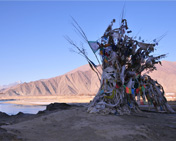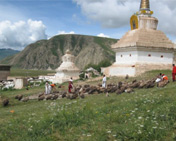
The Tibetan funeral is imbued with Buddhist belief in reincarnation. It is a ceremony to expiate the sins of the dead and a guarantee for the future life of the dead. Tibetans are not afraid of death. They believe that death does not terminate a life, but indicates rebirth. Generally, funeral rituals practiced in Tibet are stupa burial, sky burial, cremation, water burial, and internment. Cliff burial and tree burial are also practiced occasionally.
Sky Burial is considered to be the dominant funeral custom in Tibet. The body is laid out in the open on the rocky terrain and meticulously skinned and dissected. The bones are crushed and mixed with tsampa. Vultures sweep down upon bloody remains and rip into the human flesh. As the bones are polished by the satisfied birds, the remains are gathered and burnt in a ceremonial fire. Tibetans believe that the majestic birds are competent for bringing the souls up to heaven.

Stupa Burial is the noblest funeral ritual in Tibet, which is reserved for Dalai Lama , Panchen Lama and Living Buddha.
Cremation is reserved for high monks and aristocrats. It is also used for commoners in the southeast of Tibet where trees are abundant.
Water Burial is considered an inferior way to dispose of those with low social status. In water burial, the corpse is wrapped with white cloth and disposed into a river.
Inhumation now is rarely practiced. It is reserved for those who died of infectious diseases or unnatural causes such as murder or accidents. According to Tibetans, these bodies are not clean enough to be presented to the vultures.
Cliff Burial is practiced in southern Tibet. The embalmed corpse is placed in a wooden box. The box is then placed in the cave off a cliff.
Tree Burial is for children, commonly practiced in Nyingchi. The corpse of the child is placed in a wooden case and hung on a tree in a remote forest.









 8 Days Nyingchi Shigatse Namtso Tour
8 Days Nyingchi Shigatse Namtso Tour  4-Day Lhasa Join-in Group Tour
4-Day Lhasa Join-in Group Tour  5 Days Lhasa Group Tour with Yamdrok Lake
5 Days Lhasa Group Tour with Yamdrok Lake  5 Days Lhasa Pilgrimage Tour to Ganden Monastery & Drak Yerpa
5 Days Lhasa Pilgrimage Tour to Ganden Monastery & Drak Yerpa  6 Days Lhasa Shigatse Group Tour
6 Days Lhasa Shigatse Group Tour  7 Days Overland Tour from Lhasa to Kathmandu
7 Days Overland Tour from Lhasa to Kathmandu  8 Days Lhasa-Shigatse-EBC-Group Tour
8 Days Lhasa-Shigatse-EBC-Group Tour  7 Days Central Tibet Group Tour with Namtso
7 Days Central Tibet Group Tour with Namtso  Data in submission...
Data in submission...


